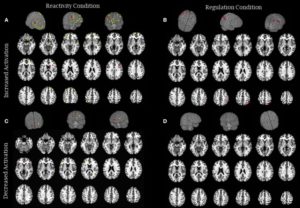Compulsive Sexual Behavior is Related to Shame and Low Mindfulness
By John M. de Castro, Ph.D.
“In addition to helping bring about a reduction in dysfunctional sex-related actions, fantasies and thoughts, mindfulness training may help affected individuals gain improved emotional control, an increased ability to handle stressful situations and improved resistance to any potentially damaging sex-related urges that arise.” – The Ranch
Sexual behavior is a very important aspect of human behavior, especially for reproduction. In fact, Sigmund Freud made it a centerpiece of his psychodynamic theory. At its best, it is the glue that holds families and relationships together. But it is a common source of dysfunction and psychosocial problems. Compulsive sexual behavior “encompasses problems with preoccupation with thoughts surrounding sexual behavior, loss of control over sexual behavior, disturbances in relationships due to sexual behavior, and disturbances in affect (e.g., shame) due to sexual behavior.” It is also called sex addiction and hypersexuality. It is chronic and remarkably common affecting 3% to 17% of the population. In addition, it is associated with substance abuse in around half of people with compulsive sexual behavior.
Compulsive sexual behavior is frequently treated with psychotherapy, Cognitive Behavioral, Therapy, or drugs with mixed success. Since, it is also looked at as an addiction and mindfulness treatment has been found to be effective for both sexual dysfunction and for addictions, mindfulness may be affective for individuals with both substance abuse and compulsive sexual behavior. Indeed, mindfulness has been shown to be related to compulsive sexual behavior in men undergoing treatment for substance abuse. This suggests that further study of the relationship between mindfulness and compulsive sexual behavior should be investigated.
In today’s Research News article “Dispositional Mindfulness, Shame, and Compulsive Sexual Behaviors among Men in Residential Treatment for Substance Use Disorders.” (See summary below or view the full text of the study at: https://www.ncbi.nlm.nih.gov/pmc/articles/PMC5764544/ ), Brem and colleagues examined the medical records of men in residential treatment for substance abuse looking at measures of mindfulness, compulsive sexual behavior, shame, alcohol use and associated problems, and drug use and associated problems. They examined the relationships between the variables with hierarchical multiple regressions.
They found that for these men in residential treatment for substance abuse, the higher the levels of mindfulness the lower the levels of compulsive sexual behavior, shame, alcohol use and associated problems, and drug use and associated problems. Hence mindfulness appears to be associated with lower levels of problems associated with substance abuse. In addition, they found that the higher the levels of compulsive sexual behavior, the higher the levels of shame and alcohol use and associated problems. Significantly, men who engaged in compulsive sexual behavior were more likely to experience shame when mindfulness was low. With average and high levels of mindfulness, compulsive sexual behavior was not related to shame.
Hence it appears that mindfulness not only is associated with lower shame but that it also appears to inoculate men who demonstrate compulsive sexual behavior from feelings of shame. Shame appears to interfere with successful treatment for substance abuse. Being ashamed increases negative feelings about the self and success in treatment is aided by positive feelings about the self. So, these results suggest that being mindful may be an asset encouraging successful treatment for substance abuse in part by reducing the feelings of shame that interfere with success.
So, reduce compulsive sexual behavior by reducing shame with mindfulness.
“The greatest aid has been, and is, the knowledge and application of mind body awareness (or mindfulness, consciousness). It was the realisation about the nature of the relationship between me (the observer) and my mind which gave me the greatest insight and a powerful tool to overcome the negative behaviour patterns that sexual addiction creates. And I am still learning everyday!” – Sex Addict
CMCS – Center for Mindfulness and Contemplative Studies
This and other Contemplative Studies posts are also available on Google+ https://plus.google.com/106784388191201299496/posts and on Twitter @MindfulResearch
Study Summary
Brem, M. J., Shorey, R. C., Anderson, S., & Stuart, G. L. (2017). Dispositional Mindfulness, Shame, and Compulsive Sexual Behaviors among Men in Residential Treatment for Substance Use Disorders. Mindfulness, 8(6), 1552-1558.
Abstract
Approximately 31% of men in treatment for a substance use disorders (SUD) engage in compulsive sexual behavior (CSB). Shame, a well-documented consequence of CSB, increases the likelihood of relapse following treatment for SUDs. Despite the risk of relapse, prior research has not investigated factors that may attenuate the relation between CSB and shame. Dispositional mindfulness is one such factor known to mitigate shame. However, researchers have yet to examine dispositional mindfulness as a moderator of the relationship between CSB and shame among a sample of men in treatment for SUDs. In an effort to inform intervention efforts, the present study aimed to investigate the hypothesis that CSB would not relate to shame among men with high, as opposed to low, levels of dispositional mindfulness. The present study reviewed medical records of 184 men in residential treatment for SUDs who completed cross-sectional measures of shame, CSB, dispositional mindfulness, and substance use problems. Results demonstrated a significant interaction between CSB and dispositional mindfulness such that CSB positively related to shame at low, but not mean or high, levels of dispositional mindfulness. These results support and extend previous mindfulness and CSB treatment research. Findings suggested that intervention efforts for CSB may benefit from increasing dispositional mindfulness in an effort to reduce shame-related cognitions.
https://www.ncbi.nlm.nih.gov/pmc/articles/PMC5764544/









